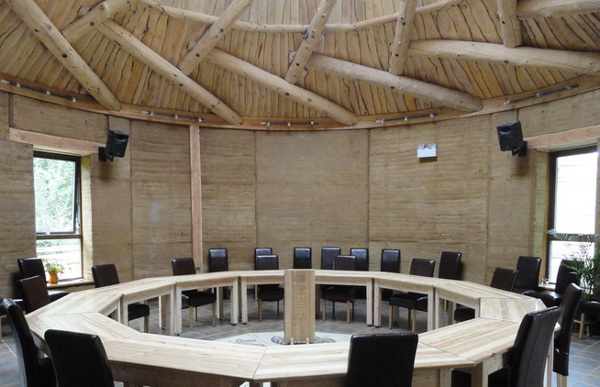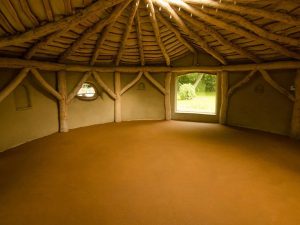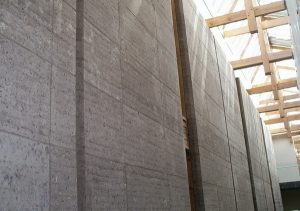Earth building, including rammed earth building, produces very low carbon emissions. However, there is a confusion between rammed earth – a mix of clay, sand and stones – and dry-pack concrete, too often called ‘stabilised rammed earth’.
The reason rammed earth stays together is a combination of the materials used, their particle size, their moisture content and the pressure applied. In this way materials as diverse as clay, chalk and laterite can all be brought to their maximum density and made into walls. This has been proved around the world by builders in England, Bhutan, China, Peru, USA, Zimbabwe, Morocco and many other places, working independently to build up to seven storeys in some cases, without resorting to any chemical binder.

Rowland plus wall
It’s an amazing thing that clay, a particle smaller than human blood corpuscles, has the ability to wrap around every other piece of silt, sand and stone and form a little electrical bond. Clay is really a remarkable material – so versatile yet so widely available. It has properties that humans have evolved with for our entire existence – such as our tolerance to a humidity level that clay is able to moderate without ‘doing’ anything. And once a wall built with rammed earth and bound with clay has reached the end of its useful life the electrical bonds the clay made in its production can be broken and re-made into a different wall again and again indefinitely.
But rammed earth walls can also be built with chalk, a naturally-formed material made from the bodies and shells of countless billions of sea creatures. Like its relative limestone, when ground down chalk has a particle size ten times smaller than clay. The bulk of chalk is made from calcium, which can also be wetted and rammed into a formwork to make a solid wall. Like rammed earth with clay, it can be broken down and rebuilt indefinitely, but is generally slightly weaker as a material, although this can be greatly enhanced with the inclusion of a small amount of clay. The bonds that chalk makes, plus the size of the particles makes it hard to say exactly what is happening, but certainly the moisture and compression involved in ramming are enough to make the chalk compact to a very high degree.
Now chalk has another property – one with grave consequences. Inside each of the tiny little shells that make up the mass of the material is a tiny piece of carbon, the remains of the living creature which made a little shell for itself and then died. That carbon grew removed a little bit of carbon from the ocean as it grew. As the carbon in sea water is absorbed from the atmosphere, over millions of years all that carbon removed from the ocean produced our current atmosphere, and allowed us to breathe. Now we have discovered that if we take a black fossil and burn it with those white chalk fossils we can separate that carbon from the calcium. Doing so, we make cement.

This tiny shell has a stable core of carbon that has to be burned out at high temperature to make cement
It is for this reason that cement has become one of the biggest single sources of human CO2 emissions – around 13% in 2012. Cement requires us to burn carbon fuels to burn carbon out of shells. In the late 20th century rammed earth and cement began to come together. After a century of growth and development, cement had become the de facto building material for the planet. Standards were written, regulations passed, insurance risks assessed and professionals and an industry trained. Cement was and is the dominant force in construction around the world. So for people thinking about environmental issues, or just looking for a new sales pitch, rammed earth seemed like a good bet. But earth on its own? Could that be enough? Surely a little cement wouldn’t hurt, could give confidence, would make rammed earth measurable and modern? And so ‘stabilised rammed earth’ was born, or as many of its advocates call it, ‘rammed earth’.
In Australia this process of changing rammed earth from something that needs soil to build to something that needs cement gives us the full arc of the process. After a time greater amounts of cement were demanded by an increasingly risk-averse market. As the cement percentage increased in the mixes, so disquiet grew on the possible effects of the clay in the earth being rammed. So more and more contracts were written demanding clay be left out of the mix. Grey cement was abandoned for its more expensive cousin white cement, to prevent the appearance of this dry-pack concrete being mistaken for ordinary concrete. And so the process was completed – rammed earth had been turned into cement, sand and gravel or what we commonly call concrete.
Now anyone trying to build with rammed earth, with nano-binders like clay are ‘purists’, with a naïve ‘philosophy’ for ignoring the giant that is cement. And yet there is a built record of multi-storey rammed earth buildings on every continent except Antarctica. Rammed earth – i.e. made from earth, and not cement. So now shouldn’t builders with cement begin to justify its use in low-rise buildings, rather than earth builders having to justify why earth should be used?
So what is rammed earth? It’s any subsoil compacted into a formwork to form a wall without producing high percentages of CO2. And if it contains cement – what do we call it then? We call it dry-pack concrete.
more on rammed earth building



